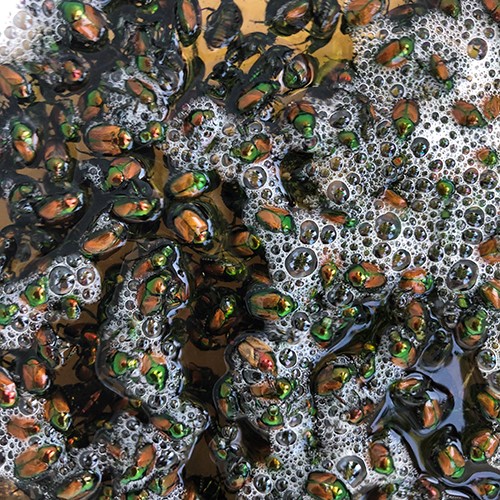CMGs Guilty of Murdering 123,059
- 2019-11-06
- By danibash
- Posted in The Garden Buzz
By Donnetta Wilhelm, Colorado Master Gardener
Houseguest
blues? You know, the ones who eat all your food, make a mess, sit around
waiting to be entertained and overstay their welcome? Like those houseguests,
Japanese beetles (Popillia japonica)
are the unwanted guests of gardeners. Japanese beetles (JB) have previously
been found in Colorado in miniscule numbers but died before permanently moving
in.
The Japanese beetle finally began overstaying its welcome in the Metro area in
the early 2000s, quickly finding suitable dwellings in well-irrigated
landscapes and golf courses. At a reproduction rate of 40-60 eggs per female
each season, populations have exploded. Most become sightseers, flying
considerable distances to find other lodging, furthering their spread.
In 2018, Colorado Master Gardener (CMG) volunteers in Arapahoe County began
assisting CSU Entomologist Dr. Whitney Cranshaw with his research. CMGs count
trapped beetles twice a week and report numbers, providing baseline data to Dr.
Cranshaw, who is testing the success of biocontrols against JB.

Japanese Beetles in soapy water.
Photo Credit: Lisa Mason
Janet Paul and Sandy Brock collect specimens.
Photo Credit: Lisa Mason
Professional research traps are strategically placed at Hudson Gardens, Sterne Park and Quincy Farm. CMGs arrive early morning to empty traps into soapy water that kills the JBs. Carcasses are packed into a measuring cup with a count of 836 beetles per cup. “The beetles are messy, and the trap was stinky” said CMG Barb Bolen. Several CMGs take bags of dead beetles to local chicken farmers. “They make great food for chickens—apparently they are 40% protein by weight—and I have found many grateful chicken farmers in the Littleton area to give the beetles to” noted CMG Janet Paul. Bolen learned not to “do errands after collecting them—they stink up a car after sitting in the hot sun!”
Biocontrols currently being tested are Ovavesicula popilliae, a fungal disease that infects Japanese beetle larvae when it is applied to the turf grass, and Istocheta aldrichi, a beneficial tachinid fly that deposits its eggs onto adult Japanese beetles. The fly larva tunnels into the beetle, eventually killing it. It may take years before the public sees the benefit of the biocontrols, and even then, “they will help decrease the populations of JB, but likely won’t provide complete control” states Lisa Mason, Arapahoe County Horticulture Agent.
CMG Zandy Wennerstrom believes that “the public needs to know what measures are being done to help eradicate the beetles and how long a study takes to find answers and viable solutions.” CMG Hans Kaufenberg adds “the public should know that while Japanese beetle traps won’t necessarily keep the pests away from our plants, the traps are essential for tracking the duration and intensity of an infestation each season.” CMG Dala Giffin sums up her commitment to the research project declaring “cute as they are, I prefer flowers to beetles and make no apologies for my part in their execution.”
Horticulture Resources
- Garden Buzz Archives
- CSU Extension Resources
- Colorado Master Gardener Program
- Foothills to Plains Native Plant Master Program
- Native Bee Watch Community Science Program
- The Co-Hort Blog
- PlantTalk Colorado
- Soil Testing
- Plant Select
- Emerald Ash Borer
- Japanese Beetle
- Colorado State Forest Service
- Ask an Expert


